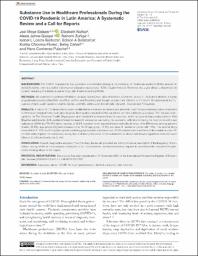Mostrar el registro sencillo del ítem
Substance Use in Healthcare Professionals During the COVID-19 Pandemic in Latin America: A Systematic Review and a Call for Reports
| dc.contributor.author | Moya-Salazar, Jeel | es_ES |
| dc.contributor.author | Nuñez, Elizabeth | es_ES |
| dc.contributor.author | Jaime-Quispe, Alexis | es_ES |
| dc.contributor.author | Zuñiga, Nahomi | es_ES |
| dc.contributor.author | Loaiza-Barboza, Isabel L | es_ES |
| dc.contributor.author | Balabarca, Edison A | es_ES |
| dc.contributor.author | Chicoma-Flores, Karina | es_ES |
| dc.contributor.author | Cañari, Betsy | es_ES |
| dc.contributor.author | Contreras-Pulache, Hans | es_ES |
| dc.date.accessioned | 2022-10-18T19:36:00Z | |
| dc.date.available | 2022-10-18T19:36:00Z | |
| dc.date.issued | 2022-03-29 | |
| dc.identifier.uri | https://hdl.handle.net/20.500.13053/6870 | |
| dc.description.abstract | BACkgROUnD: The COVID-19 pandemic has generated a remarkable change in the behaviour of Healthcare workers (HCWs) around the world. However, there is a lack of evidence on substance use among HCWs in Latin America. Therefore, this study aimed to determine the current frequency of substance use among Latin American among HCWs.MeTHODS: We searched 8 databases (PubMed, Scopus, ScientDirect, Web of Science, Cochrane, Scielo, LILACS and Latindex), 4 public prepublication servers (SocArXiv, medRxiv, bioRxiv and Preprints) and Google scholar from 1/9/2019 to 11/1/2021. We determined the fre-quency of each study based on original studies, scientific letters, and clinical trials in English, Spanish and Portuguese.ReSULT S: A total of 17 175 study articles were identified from electronic databases and preprints, and 2 cross-sectional studies conducted in 2020 were included in the qualitative analysis. Both studies included HCWs but did not perform a differential analysis. The first was devel-oped by the Pan-American Health Organization and included interviewees from 35 countries, while the second was conducted with 1145 Brazilian participants. Both studies showed increases in substance use during the pandemic, with alcohol being the most commonly used substance (30%), but PAHO’s study reported a 13.8% increase in self-reported heavy-episodic drinking, with differences among genders (males, 15.4%), age groups (highest increase in the 40-49 age group, 16.5%) and area of residence (urban with 14%). The second study showed that 21 32% of participants reported initiating psychoactive substance use, 29.3% added some substance to their initial use and 4% of them had to replace the substance, mainly due to difficulty of access. Other substances of abuse that showed significant increases were tobacco (0.5%) and marijuana (0.3%).COnCLUSIOn: Overall, despite the analysis of the 2 studies, the results provided are not a conclusive description of the frequency of sub-stance use by HCWs in Latin America during the COVID-19 pandemic. Further research is required to understand the impact of the pan-demic on drug abuse in the region.PROTOCOL RegISTRATIOn: The protocol has been registered on 30 November 2021 on the International Prospective Register of System-atic Reviews (PROSPERO) with ID: CRD420212919700 | es_ES |
| dc.format | application/pdf | es_ES |
| dc.language.iso | eng | es_ES |
| dc.publisher | SAGE Publications Ltd | es_ES |
| dc.rights | info:eu-repo/semantics/openAccess | es_ES |
| dc.rights.uri | https://creativecommons.org/licenses/by/4.0/ | es_ES |
| dc.subject | Substance abuse, COVID-19, health professionals, alcohol, cannabis, Latin America | es_ES |
| dc.title | Substance Use in Healthcare Professionals During the COVID-19 Pandemic in Latin America: A Systematic Review and a Call for Reports | es_ES |
| dc.type | info:eu-repo/semantics/article | es_ES |
| dc.identifier.doi | https://doi.org/10.1177/11782218221085592 | es_ES |
| dc.type.version | info:eu-repo/semantics/publishedVersion | es_ES |
| dc.publisher.country | NZ | es_ES |
| dc.subject.ocde | http://purl.org/pe-repo/ocde/ford#3.03.00 | es_ES |
Ficheros en el ítem
Este ítem aparece en la(s) siguiente(s) colección(es)
-
SCOPUS [380]


